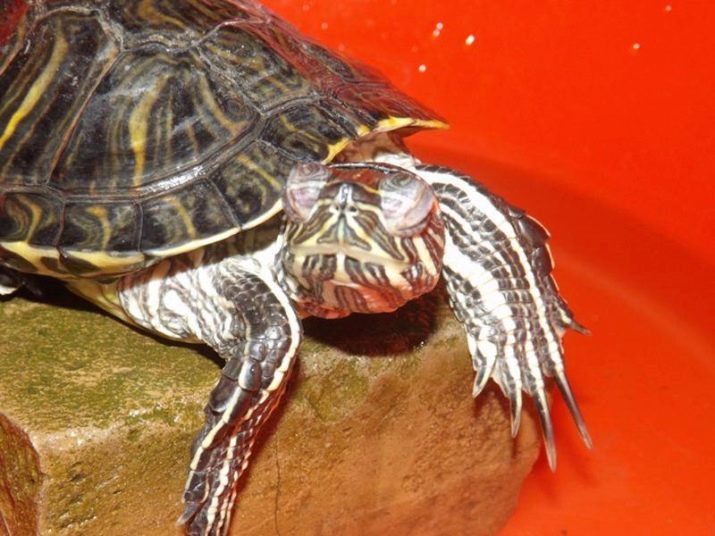Caring for a red-eared turtle at home
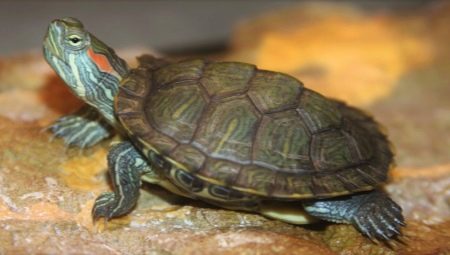
Red-eared turtles are gaining in popularity lately. These small reptiles are convenient to keep at home. They do not require a walk, constant observation by a veterinarian, do not stick to the owners, demanding attention. However, certain conditions are very important for them. And you should familiarize yourself with them even before purchasing a pet in order to decide exactly whether you want such a friend or not.
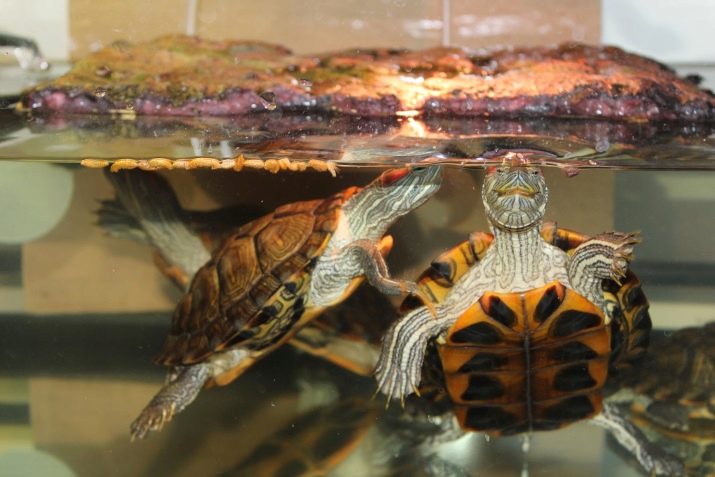
Choosing an aquarium
The red-eared turtle is a small reptile that is widespread on many continents of the planet. For a comfortable stay, the animal needs water, therefore, first of all, you need to take care of buying an aquarium. If it does not meet the norms, the reptile can start to get sick, and its life expectancy will be seriously reduced. In good conditions, redfishes live from 30 to 40 years.
For the full development of turtles of the described species, aquaterrariums and paludariums are most suitable. The paludarium is a special type of aquarium that is very suitable for turtles. It has a thick rear wall and impressive sidewalls, and also has an intricate descent into the water area. Some redhead owners believe that pets can be kept in plastic containers. But it is not so. Plastic gets dirty quickly, it cannot be the main material for the house.
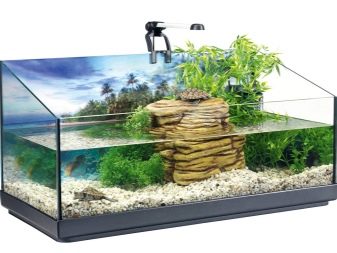

Plastic housing can only be considered temporary. For example, when the turtle is in quarantine, you need to take it to the doctor, or you ask someone you know to look after it while you are on vacation.
It should be borne in mind that the turtle grows for the entire period of its life, albeit little by little, almost imperceptibly, but still. The aquarium should be such that the animal is not cramped in it.On average, one adult turtle should have 120-150 liters. Such a volume of the aquarium will allow the animal to exist alone. Two turtles can be kept in a 200 liter aquarium. If there are more individuals, the appropriate size is selected. The kid can be kept in an aquarium of 50-80 liters.
Besides, the aquaterrarium should be divided into zones. Little red dogs need both water and dry land. Water should occupy about 75%, land - 25. Usually it is a lit island. Another point of choosing an aquarium is the presence of a cover. Without her, the pet can escape. The lid should be perfectly breathable and fit snugly to the aquarium.
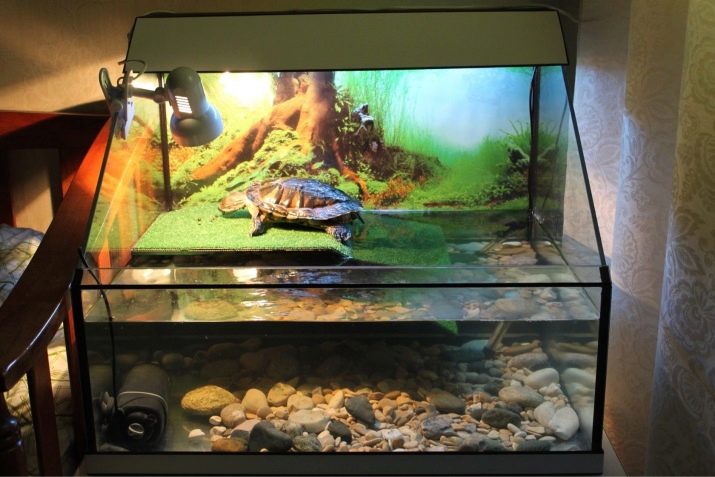
Conditions of detention
Keeping turtles at home is not difficult, the main thing is to immediately think over all the nuances of arranging an aquarium.
Aquarium equipment
For a comfortable life, the turtle will need minimal filling in the aquaterrarium. The first important point is an island of land, where the pet will warm up and relieve its natural needs. There are a lot of such islets in pet stores, and they may differ from each other. For example, there are options without fasteners, submerged in water, and options with suction cups.
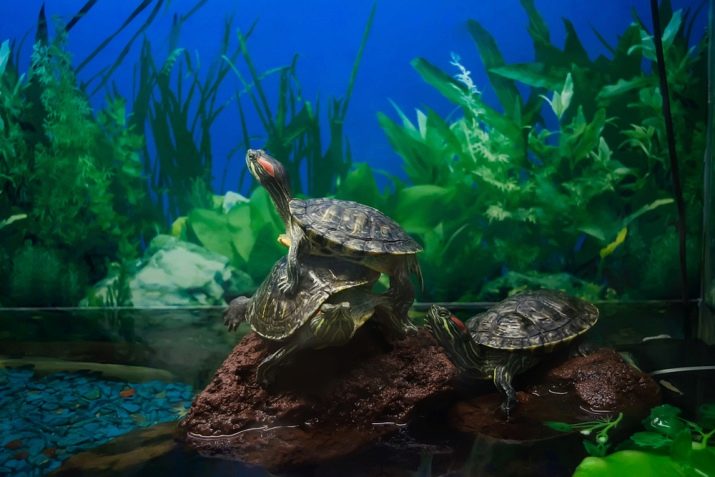
The latter should not be chosen for adult pets, otherwise the island may not support the turtle's weight and fall with it, which is fraught with injuries.
The islet should have rounded edges so that the animal does not get hurt. A stable and sturdy surface is another essential requirement, as is easy access to and from the water. The land should be made of solid materials that do not contain harmful impurities and toxins. We have already mentioned that it should occupy about 25% of the aquarium. From the beginning of the land to the wall of the unit should be about 20 centimeters. The temperature on the island is set 10 degrees higher than the water parameters. The minimum indicator of the shadow zone is 23 degrees, the maximum illuminated is 32.
In addition to the island, the aquarium should be equipped with a thermometer. Better if it is in the form of a tube immersed in water. Without a thermostat, it will be very difficult for you to control the conditions in the red carpet's home.
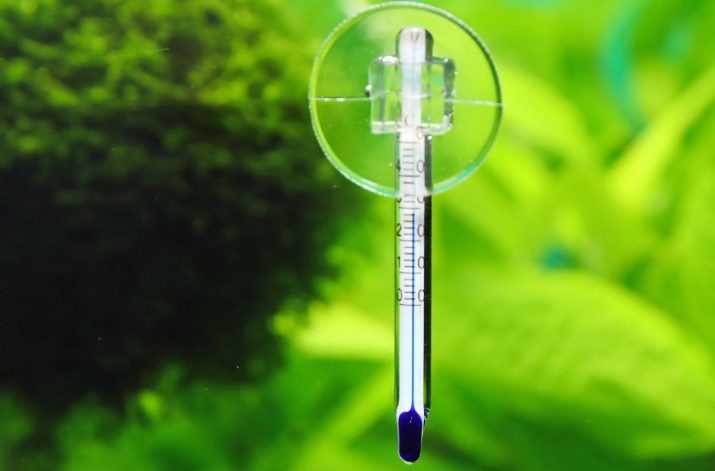
An additional point is the decoration of the aquarium. We are all accustomed to the fact that an aquarium is beautiful, bright, colorful. But in the case of turtles, you should be as careful as possible. If you need to put soil, then you need to choose rather large pebbles, no less than the pet's head. Otherwise, the turtle will swallow the soil, which can lead to its death.
It is not recommended to plant beautiful colored algae. Many of them are poisonous, and the turtle is extremely curious. She will try them one hundred percent. If you really want to, you can plant artificial variations of algae. The fish in the aquarium are useless, in a couple of weeks everything will be eaten. But the pet will like a variety of grottoes, as well as driftwood. The turtle will love to explore them. Only all this should be disinfected in advance.
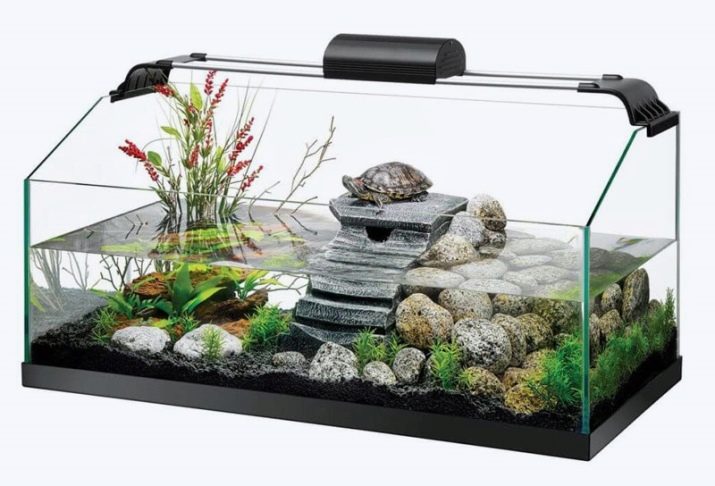
Lighting
Waterfowl turtles in nature live in illuminated places. They love the sun, they need light. You will need two types of lighting.
- Ultraviolet. It is impossible to do without this lamp, although it does not warm. But such lighting has a positive effect on the tortoise shell, strengthens it, and counteracts rickets. The lamp should burn for an average of 3 hours a day. The device should be placed at a height of 0.3 meters above the island. For babies and young animals, choose a lamp with 5% ultraviolet radiation, for adult pets - 10.
- Heating. Such a lamp allows you to maintain the required temperature in the red carpet's dwelling. You can take an ordinary 60-watt light bulb, it will be enough. Place it at the same height as the ultraviolet one. They are turned on for 12 hours, that is, for the entire period of the pet's wakefulness.
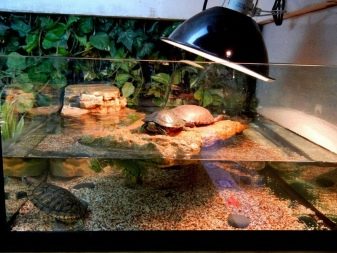
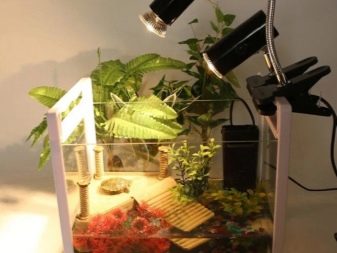
In the case of both bulbs, it is important to insulate them with high quality so that no water gets in.
Also some owners install infrared light sources. They can help if the temperature in the aquarium drops below normal during the night. During the day, these bulbs are not included.
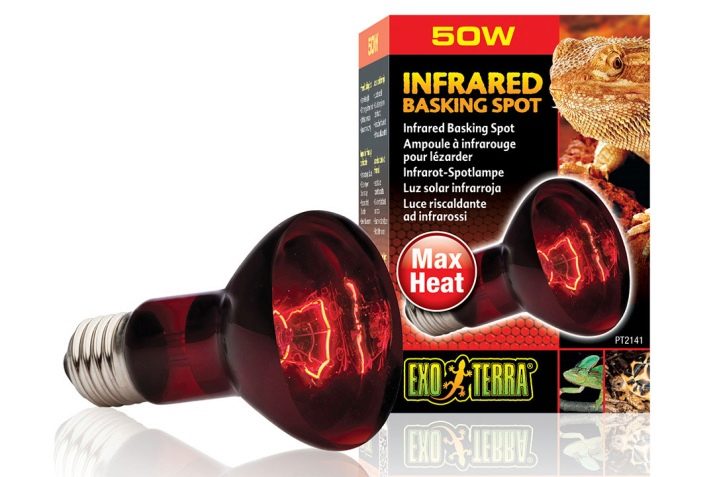
Water
Most of their time turtles splash in the water, one might say, they live there. Therefore, the level and quality of the liquid must be monitored especially carefully. Filtered or settled liquid is suitable, and it should settle for at least 24 hours. The optimum temperature is 22-28 degrees, if you cannot reach it, you should use a heater. Both the heater and thermometer should be protected so that the turtle does not taste them.
In order not to have to change the water several times a week, it is recommended to install a filter. It will purify the liquid, which will greatly improve the turtle's quality of life. It is better to give preference to an external filter, as pets get to the internal ones very quickly.
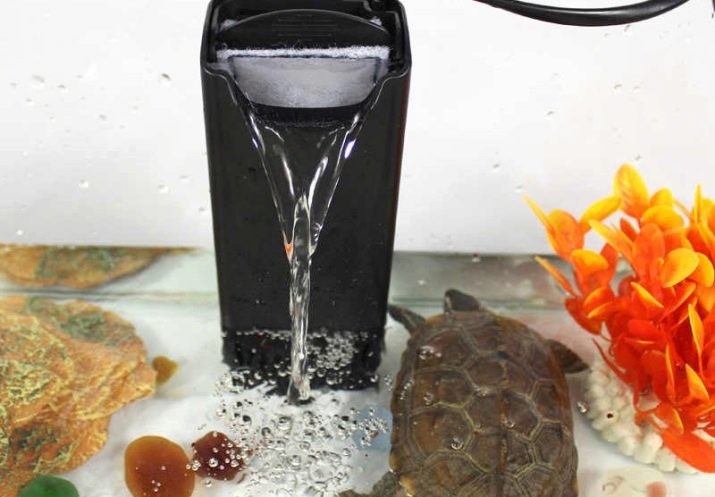
Depth parameters are not very important for redheads, but it is imperative that the level is twice the diameter of the shell. Then the animal will be able to roll over and somersault, which it loves to do.
The larger the turtle, the higher the water level should be.

Feeding
Nutrition is an important element in the care of the red-eared turtle. There are a few things to keep in mind here. The first is the need for two types of feed: animal and vegetable. The animal should be the main one, form the foundation of the diet of a young turtle. Little turtles under 2 years old should receive 90% of animal protein daily, while adults are partially transferred to vegetable protein. They have 70%, the remaining 30 are animals.

You can feed the turtles with the following foods:
- shrimps;
- small molluscs;
- lean fish;
- worms;
- cockroaches (adjustable);
- frogs;
- liver, heart;
- daphnia;
- crickets;
- hamarus (fresh).



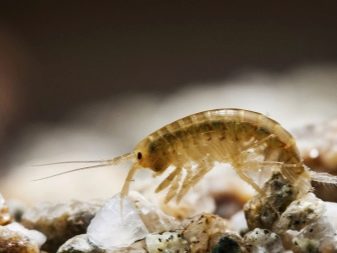
Adult turtles are also very fond of plant foods, which include:
- dandelions;
- duckweed;
- water hyacinths;
- carrot;
- lettuce leaves;
- seaweed;
- hornwort.

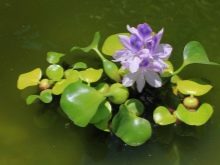
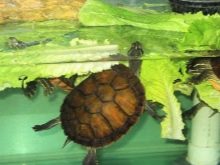
You should not feed turtles with fatty meat, fish, all kinds of sausages and sausages. Sweets are strictly prohibited. Fruit can be given, but rarely, just to pamper. They contain sugar, which turtles do not need.
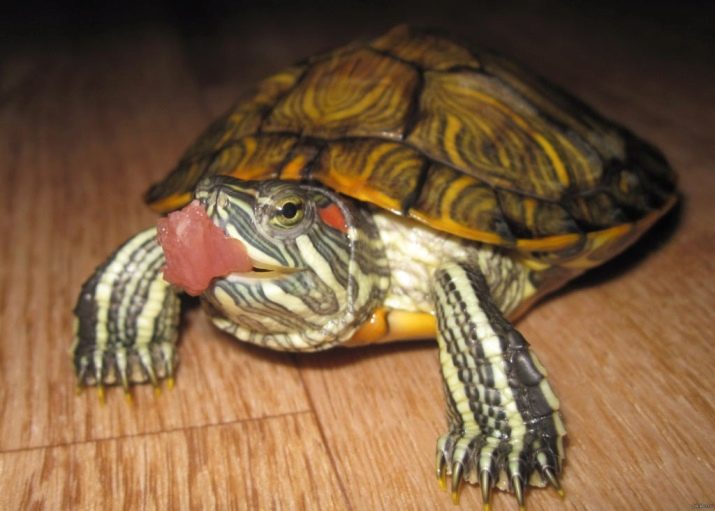
This is interesting: some owners of turtles specially breed fish with them in the aquarium. The fish here do not serve as decoration, but exclusively as a source of food for small predators.
Let's consider a few more important rules for feeding turtles.
- You need to feed the animal once a day, it does not matter how old it is. Babies up to two years old are fed every day, and adult pets are fed every 2 days.
- The serving should be half the size of the shell. In this case, the food is crushed. The size of the piece is ½ of the volume of the head of the redfly. If the animal does not finish the portion or refuses, do not insist. Take away the food this time and give a little less next time.
- Do not feed your turtle in an aquarium, but in a special jig. So you do not have to constantly clean the animal's dwelling from food debris. The jug should be large enough for the turtle to turn in it. It is worth pouring a little water at the bottom, since the pet only eats food soaked in liquid.

Cleaning
A turtle living at home should be properly cared for. Another point of mandatory care is cleaning the aquarium. The frequency will depend on the age of the pet. While the turtle is small and the terrarium is small, you will have to clean it more often, about once a week. Large terrariums are cleaned once a month and a half.

Now let's look at the main points of cleaning.
- The turtle is placed in a jig or other suitable container. Pour water and place a couple of stones there so that the pet can sit on land if desired.
- The aquarium is disconnected from the network, thermometers, filters and other equipment are removed. Then they take out all the other items: soil, decor, and so on.
- Drain the water completely, then rinse the aquarium under high pressure several times.The water inside should be clear.
- Make a cleaning solution. To do this, dissolve 0.1 liters of white vinegar or the same amount of bleach with chlorine in 4 liters of water.
- Take a sponge, dampen it in the solution and thoroughly wash all surfaces, especially the corners. Then disassemble the equipment and clean it. Wash the decorations last. It is enough to simply rinse the soil with plain water.
- Rinse off thoroughly. Then dry the aquarium from the outside with a towel. Take it to the place.
- Return whatever was taken for cleaning. All instruments, islet and lamps must return to their places, otherwise the turtle will be disoriented in space.
- Fill the container with water prepared in advance, adjust its temperature. Now you can put the turtle in place.
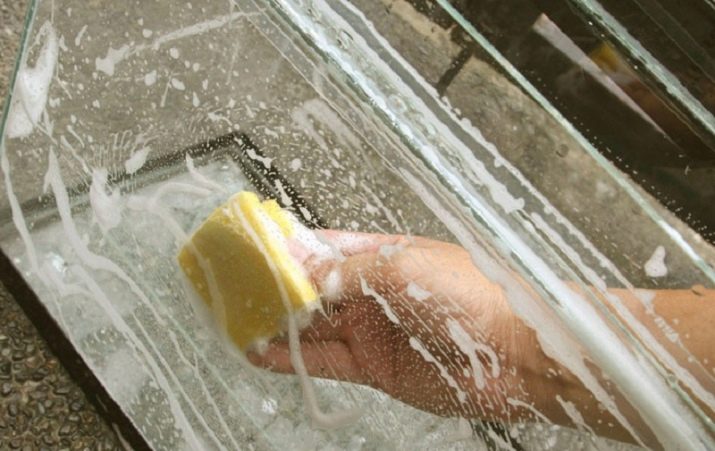
If the aquarium is too large and it is difficult to move it, then you do not need to remove it. The soil is left at the bottom, the decor is pulled out. The soil will need to be rinsed with a siphon (sold at pet stores), the glass should be cleaned with a scraper, then the bottom should be cleaned.
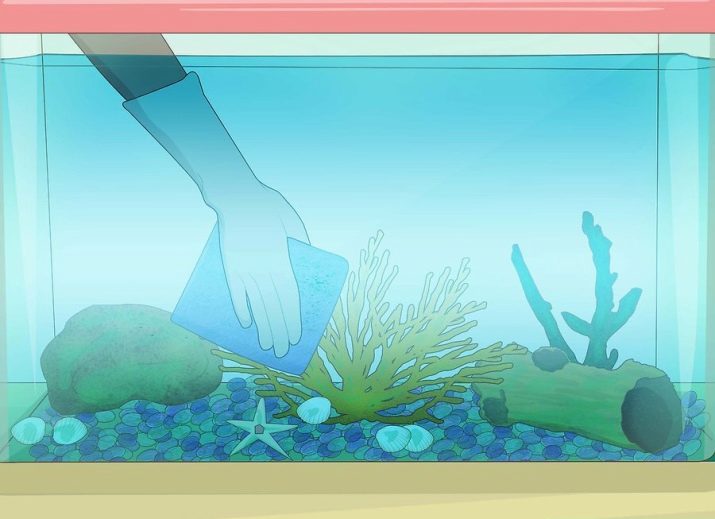
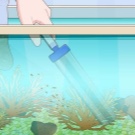
It is only necessary to completely replace the water during the described cleaning. Otherwise, it is replaced from time to time by a third, so as not to upset the balance of microorganisms.
Useful Tips
It is also worth highlighting a few tips that will definitely be of interest to those who are planning to have a red-eared pet.
- Females have no maternal instinct. Therefore, they must be kept away from newborn babies and masonry.
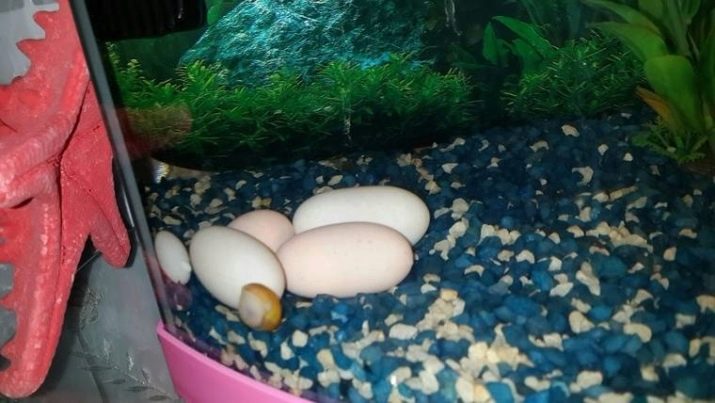
- Do not think that the turtle will get bored without relatives. This is not so, in nature they do not live in flocks. If you really want several turtles, it is permissible to take only a female and a male, or 2-3 females and one male. Two boys on the same territory - constant fights and injuries, no matter how hard you try to make them friends.
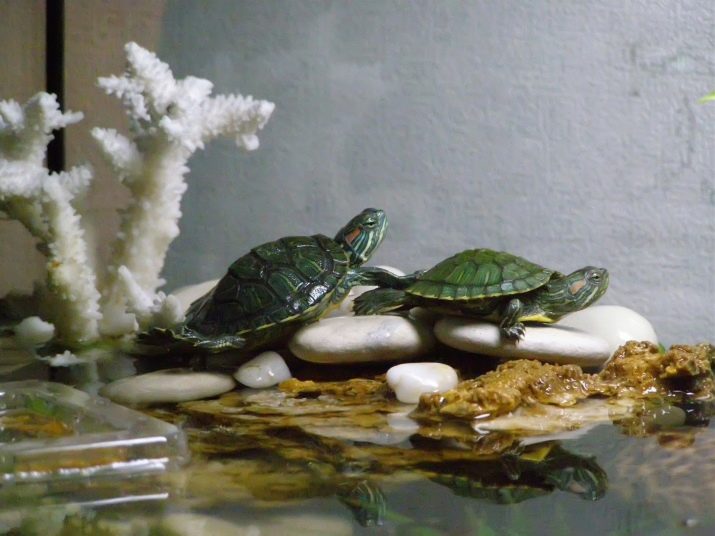
- When turtles are kept together, the aquarium will have to be divided into zones so that everyone has the opportunity to retire.

- You need to take the turtle with both hands at once, otherwise it may slip out. They take the animal by the shell in the tail, otherwise it will bite.
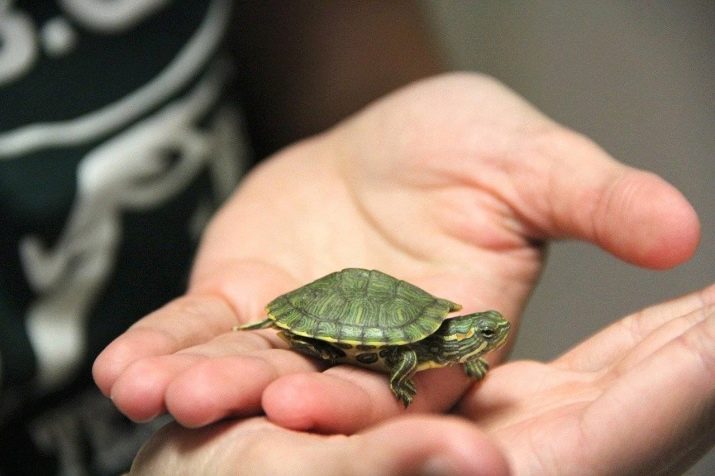
- After each communication with your pet, you should wash your hands well. It is strictly forbidden to use kitchen sponges and containers for cleaning the aquarium, as well as to use the turtle jig for personal purposes.

- Babies are not taken in their arms, as are recently purchased turtles. These pets are prone to psychological disorders, you do not need to frighten them in vain. Even a simple knock on glass can cause psychological trauma in an adult turtle.
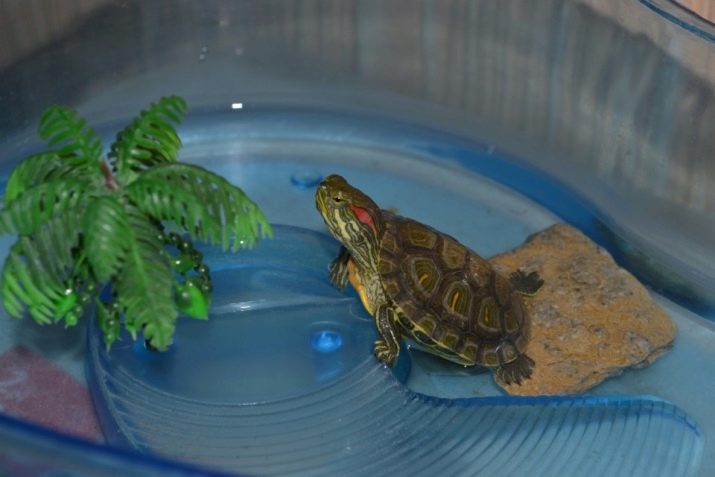
- You need to bathe your turtles once a week, using a separate container, warm water and baby soap.
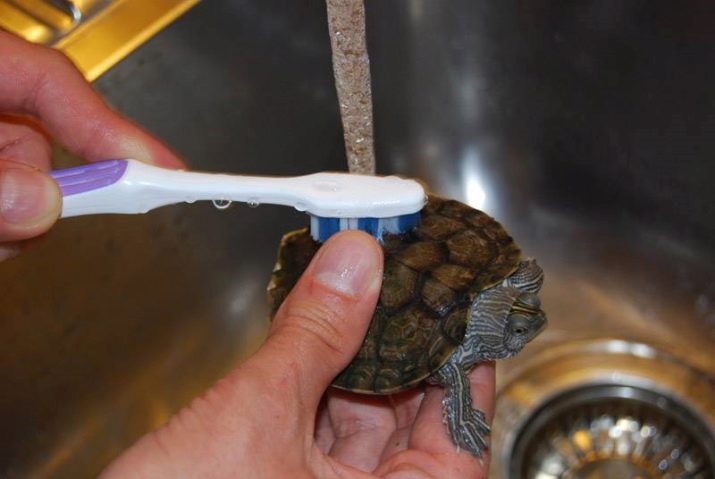
- From time to time, the turtle grows claws, which makes it difficult for its movement. They can be cut with regular nail scissors. It is also often necessary to trim the beak. The first time it is better to let the veterinarian do it, and you take a look.
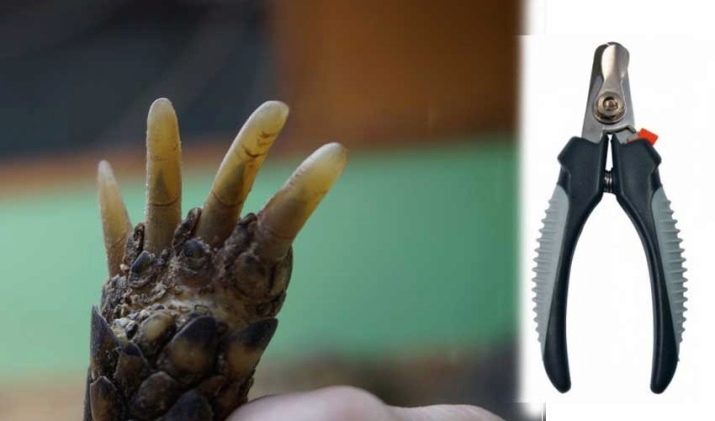
- Salt cannot be added to the aquarium, as for some fish. Such turtles are freshwater, it is harmful to them.
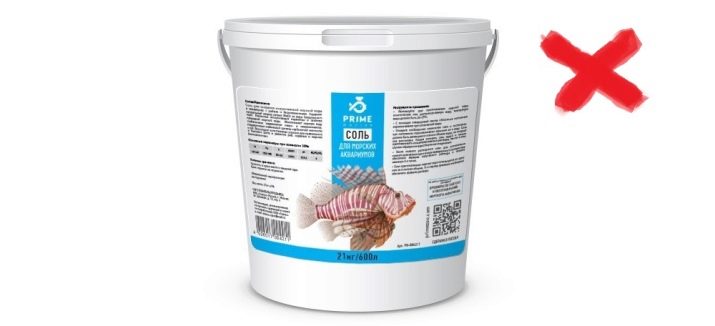
- Little red dogs can hibernate in winter. Not always, but they can. If this happens, there is no reason to panic. It is necessary to lower the depth of the water, give smaller portions of food and carefully monitor the pet.
